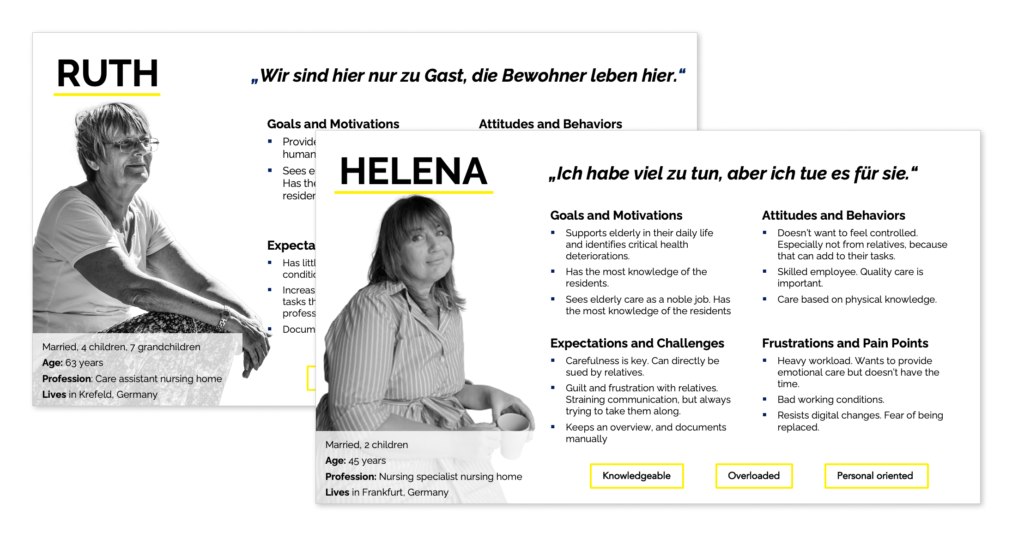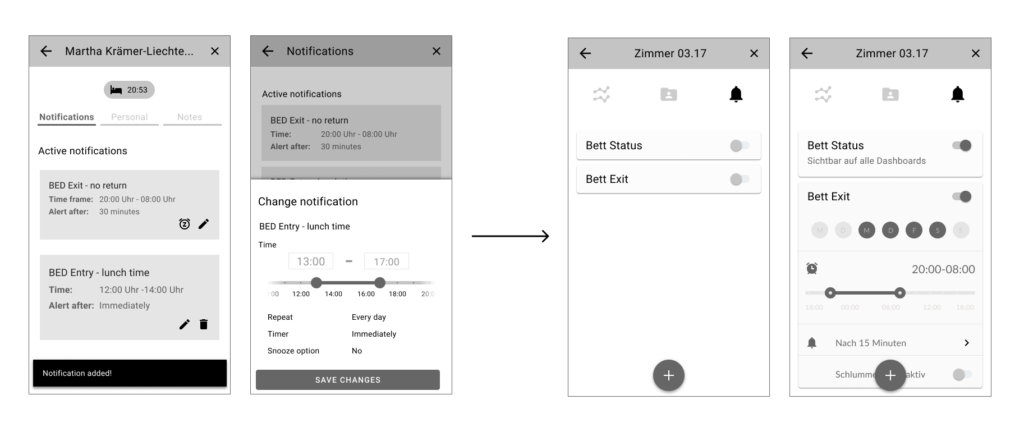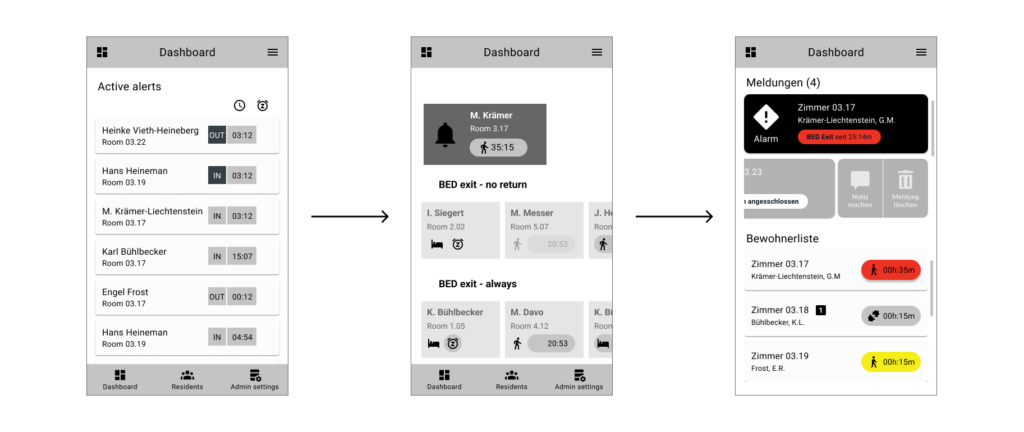Project duration: February 2022 – May 2023
Deliverable: Application for iOS and Android
My role: UX Designer, UX Researcher, UI Designer, Project Manager
Tools used: Figma, Illustrator, Miro, UsabilityHub, MS Sharepoint, JIRA

I did this project in my full-time role as a UX Designer for a digital healthcare startup in Berlin, which produces bed sensors in elderly care homes. The solution which consists of a non-evasive sensor, which can be mounted underneath a care bed, and the application, has been certified as a medical device. My task was to develop an application that translates the raw data from the sensor to applicable information for the user.
The Challenge
The sensor solution revolves around assisting caregivers in nursing homes in their daily activities through monitoring some aspects of their residents’ health when they are in bed.
e main goal of the MVP was to build a modular infrastructure which lays the groundwork for a notification system, to inform caregivers about certain behaviours regarding the residents, and an information system through which the history and and trends can be viewed.
We started with bed exits, bed entries and and basic movement data, which can later be extended to include other types of data.
Development process
Design Thinking
I lead the project from conception to implementation. The whole app development was structured around the Design Thinking model, which allowed me to make iterations in a well-structured way. Many phases, such as the user flows and wireframes, had up to 5 rounds to make our concepts come into fruition.

Collaboration
Teamwork was what made this project a success. As the UX designer I was at the heart of the process, but the development was not possible without close collaboration with the product owner, backend developer, and CTO for the concept and ideation phase, external designers for the UI ideation, the clinical evidence manager for the testing phase, and a frontend development team, together with the backend, for the implementation of the app.
Problem definition
The major focus of the solution is to offer assistance to the caregivers, by giving them peace of mind. For the MVP we decided to focus on measuring bed behaviour, as this is a major concern in nursing homes.
Falls can be detrimental to the health of elderly people, as this can lead to reduction in mobility, fall anxiety, and even death. In addition, the lying time on the ground also has a great impact on the recovery process. Also, informing nurses about bed entries during the day was seen as beneficial this could disrupt the day/night rhythm of residents. Therefore, we setup a notification system.
Problem Statement
„We want to reduce the workload of the caregivers in the nursery homes, by actively helping them reducing the number of incidents due to unnecessary bed entries and exits, and knowing the ins and outs of bed residents – without being in the room.”
We will support them by:
- Notifying the caregiver when a bed entry or exit has taken place
- Real-time display of bed status (in bed, not in bed)
- Reducing and preventing the number of injuries due to bed exits
- Notifying the caregivers if a resident hasn’t returned after a certain amount of time.
- Pro-active updates on resident bed routines
User Approach
Caregivers in elderly care homes are a difficult user group to target for user interviews or initial user testing, due to the staff shortage and a high workload. Therefore, we took the approach to first gain user information from second-hand sources, such as sales companies for nursing homes and managers who know about their processes, in order to develop the initial wireframes and test them with the target user group when we were more in concept phase.
User Personas
We identified caregivers working in nursing homes as main users of the app. Therefore, the development of the core app was focused on their user needs. Below are the user personas of the nursing specialists and the care assistants. Even though their demographics seems to be shifting from the traditional older nurses to a younger generation, it was still important to take their needs with regard to digital changes into account, since this impacted our design process.

User journeys and user flows
In the user journeys we identified that, due to staff shortage in elderly care and the overwhelmingly amount of (physical tasks), the caregivers need to prioritise their time. Since our app is an assistance and also requires administration, time spent in the app needs to be as short and concise as possible. Below is the most important flow for the caregivers in the app: solving an incoming (push) notification.

Information architecture
As said, the main function of the MVP is to provide caregivers a notification and information system to monitor their residents. However, in order for this system to properly function, the system needs to be configured in the backend of the app, which is only accessible to a part of the users.
Basic structure
The initial sketches underwent several iterations, which needed to include the below user requirements:
- The possibility to receive individual push alerts when there’s a bed exit or a bed entry violation by a resident.
- The possibility to customise the notifications for each resident.
- Following the current procedures that the caregivers use to document unusual bed procedures.
- Creating an intuitive sequence to pair sensor devices with a room and create resident profiles, and user management.
- Grouping the residents together in living areas, to which the users can opt in or out.

Sitemap
We identified various user levels in the app, depending on their responsibilities within the nursing home (identified during user research). For the MVP, the access increased with user level. This is reflected in the sitemap through color coding. The page names have been blurred for NDA purposes.

The wireframes development process
The creation of the wireframes went through three internal iteration rounds, before it was ready to be tested with users from the field.
- The dashboard evolved from a notifications-oriented section, to a dynamic section where the user-specific resident list can be accessed as well.
- The resident bed status (in or out of the bed) is directly visible on the dashboard through the resident list.
- The resident profile can be accessed directly from the dashboard.
- The notification settings are pre-configured, which can be added, removed and modified.
- All notifications can be temporarily snoozed.
App testing through user interaction
Formative evaluation
After we managed to translate our concept into the first mid-fidelity prototype, it was easier to demonstrate our concept to caregivers and gather more feedback.
I conducted several expert interviews with potential users from the field. Even though the nature of their jobs was different, they all worked in elderly care. All interviews were conducted remotely through a video call, and a moderated walk-through the app prototype. Since we were still in the exploratory phase, the users were encouraged to tell how our app can be improved to assist in their day-to-day job rather than to validate the wireframes.
Additionally, in order to better understand what the caregivers are dealing with in their day-to-day job, we were invited to do a 2-day internship in a nursing home, where we participated in a night shift and received dedicated time onsite with caregivers to understand their administrative processes and how our services could benefit them.
Insights
The most significant insights that we’ve gained were:
- Caregivers are to high degree empathy-driven. The work that they do prioritizes the health and well-being of their residents, and other activities are regarded secondary.
- The needs of each resident are unique, which is tailored to in their care plan. Knowing how they operate is crucial for the caregiver and pattern deviations are suspicious.
- “We are only guests. The residents live here”. Wherever possible, respect the privacy of the resident.
- Caregivers know the routines of their residents. Their autonomy is important to them and shouldn’t be taken away. Therefore, the app shouldn’t replace their work, but it should considered as an assistant.
- Time, or more the lack thereof, is crucial. All processes are catered towards providing care, and administration should be take the least time as possibly.
- There’s a lot at stake for caregivers, residents with deteriorating health problems, accountability to relatives, and time pressure. This makes them hesitant to “make mistakes”.

App iterations
The user testing brought significant insights and mature developments to our prototype. I will highlight the major updates to our wireframes.
Notification settings
The reasons for using the notifications differed greatly between caregivers. It could be either pure for short-time monitoring when a pattern change occurred, or for residents at risk for falls or with cognitive impairment, to full-time monitoring. To accommodate to these needs we decided to make the notifications fully flexible. Instead of having pre-configured notification settings, which can be adapted later on, new notifications can be added and entirely configured. In addition, the visibility of the bed status can be easily switched on and off without this affecting the notificatios.

Color and icon use
All three caregivers indicated that warnings and alarms should be visualized with powerful colors. We already added some basic colors to the wireframes (see below image), which was later extensively developed as the traffic light system in our design language. Additionally, icons became more prevalent to improve the simplicity.
Notification solving
The dashboard underwent a major update by simplifying the notification process through dividing the solve sequence into instant delete and adding an optional note. Additionally, the process was made more intuitive by sliding the notification to the right.

UI Ideation
The development of the UI language was conducted together with the app developer, and some input from the brand design company who set up the new design language.
Since urgency of the notifications is at the core of our system, we decided to further explore this. The traffic light system, since it’s an universal symbol, became the leading component within the UI language of the app. Red is used for alarms, and orange for warnings. As it is extended to the room list, residents with no activation of the sensor notifications have the green color to signify “everything is ok”.
Since the traffic light system has a practical use to it to inform the user, and needs to stand out, the basic colors were kept modest. The yellow accent tone was adapted for accessibility, but still kept bright to showcase our language, and adding playfulness to the app.
App implementation
Frontend and backend development
For implementation of the app, we worked together with an external app development company. Since they were located abroad, the frontend development of the app was fully done remotely. That, together with the backend development being in-house, made the implementation challenging, due to longer communication cycles.
However, this process also was a steep learning curve in effective communication, besides all the technical challenges that come along with front- and backend development. Additionally, during the implementation phase, we encountered many new technical insights which also affected our infrastructure.
Technical verification
In order to validate that the app was functioning as we intended, we set up a full list of app requirements, which I validated through extensive technical testing.
App validation
In the final stages of the app development we conducted a summative evaluation, together with the sensor installation sequence, in two nursing homes in Germany to investigate the usability and potential hazards of our solution, testing are generalisable to actual use. Therefore, caregivers were tested during their shifts, with actual care beds in elderly homes.
Setup
Test scenarios included:
- Installing and assigning a sensor to a room.
- Solving an alarm notification.
- Changing notification settings.
- Adding a new user and deleting a user.
- First-time login and password reset.
Participant type: caregivers in elderly homes
Test duration: 30-40 minutes
Data collection: observation, feedback questions on difficulty, screen recordings
Scenarios: tested scripts
Test devices: iPhone and Android (alternating)
Evaluation
The app was perceived as relatively intuitive in use We observed most difficulties in finding the starting point for some of the tasks. This can be explained as explorative behavior, which can be seen as common in first-time use without the help of a manual. Mostly, after this most participants had little difficulties in completing the task sequence.
Reflections
In May 2023 the first version of the application was released. This project has been a steep learning curve in my understanding of app development, since I was involved in every aspect.
- The importance of conceptualisation and designing with the user needs in mind when developing. The user profile demanded simplicity above all, and these restrictions allowed us to find new creative ways.
- Working in teams and the acceptance that good ideas can come from everyone was a humbling experience, since as designer we’re taught to have a magical staff when it comes to finding solutions.
- The translation of the designs into an actual functioning system architecture, and navigating between UX design, frontend and backend development brought the app development to a whole new level. User needs are important, but also creating clear technical requirements and understanding how to do it.
- The influence of user testing. This caused a major leap in the maturity of our wireframes, which was proven successful in the intuitiveness of the app development.




